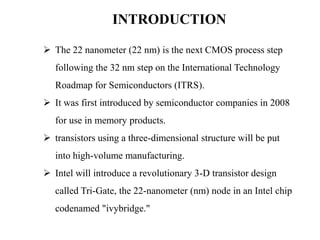22 nano meter technology
- 1. VELAGAPUDI RAMAKRISHNA SIDDHARTHA ENGINEERING COLLEGE A PRESENTATION ON 22 NANO METER TECHNOLOGY PRESENTED BY G.LALITHA
- 2. INTRODUCTION ï The 22 nanometer (22 nm) is the next CMOS process step following the 32 nm step on the International Technology Roadmap for Semiconductors (ITRS). ï It was first introduced by semiconductor companies in 2008 for use in memory products. ï transistors using a three-dimensional structure will be put into high-volume manufacturing. ï Intel will introduce a revolutionary 3-D transistor design called Tri-Gate, the 22-nanometer (nm) node in an Intel chip codenamed "ivybridge."
- 3. INTEL TECHNOLOGY ROADMAP Process name P1266 P1268 P1270 P1272 P1274 Lithography 45nm 32nm 22nm 14nm 10nm 1st Production 2007 2009 2011 2013 2015
- 4. MOORE'S LAW ï Moore's Law is a forecast for the pace of silicon technology development that states that roughly every 2 years transistor density will double, while increasing functionality and performance and decreasing costs. ï Transistors continue to get smaller, cheaper and more energy efficient in accordance with Moore's Law - named for Intel co-founder Gordon Moore. ï Because of this, Intel has been able to innovate and integrate, adding more features and computing cores to each chip, increasing performance, and decreasing manufacturing cost per transistor.
- 5. TRANSISTOR INNOVATION ENABLE TECHNOLOGY
- 6. 22NM 3-D TRI-GATE TRANSISTORS ï while meeting the overall power, cost and size requirements for a range of market segment needs. Replacing the "2D" gates with super-thin fins that rise up from the silicon base. ï Ivy Bridge-based Intel Core family processors will be the first high-volume chips to use 3-D Tri-Gate transistors. ï The performance, functionality and software compatibility of Intel architecture while meeting the overall power, cost and size requirements for a range of market segment needs.
- 7. PLANAR VERSUS "3D TRI-GATE" TRANSISTOR DESIGN
- 8. MULTIPLE FINS CAN BE ADDED TO PRODUCE OVERALL HIGHER PERFORMANCE
- 9. 22 NM TRI-GATE TRANSISTOR
- 11. A COMPARISON BETWEEN INTEL 32NM AND 22NM TECHNOLOGY
- 13. INTEL CONTINUES TO LEAD, USERS CONTINUE TO BENEFIT ï Introduced at the end of 2011, the 3rd generation Intel core processor is the first high-volume chip to use 3-D transistors. ï As Intel continues its product leadership for servers, pcs, laptops, and handheld devices with 22nm 3-D transistor technology, consumers and businesses should expect faster computing and graphics, and longer battery life in a variety of sleek form factors.
- 14. REFERENCES * http://www.intel.com/technology * http://www.google.co.in * http://www.electroiq.com * http://www.techpowerup.com * http://www.chipwork.com/technology * http://www.techterm.com
















